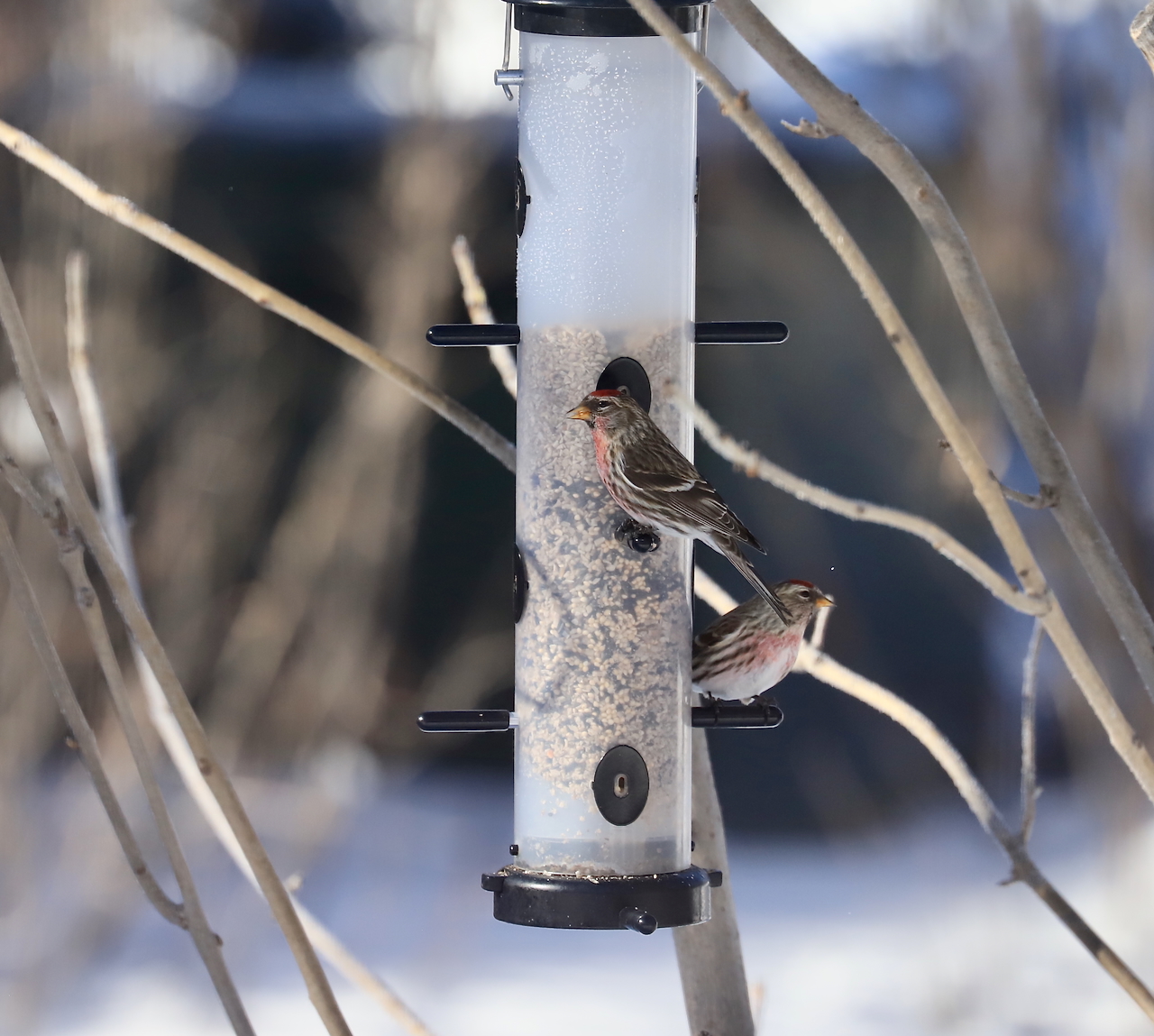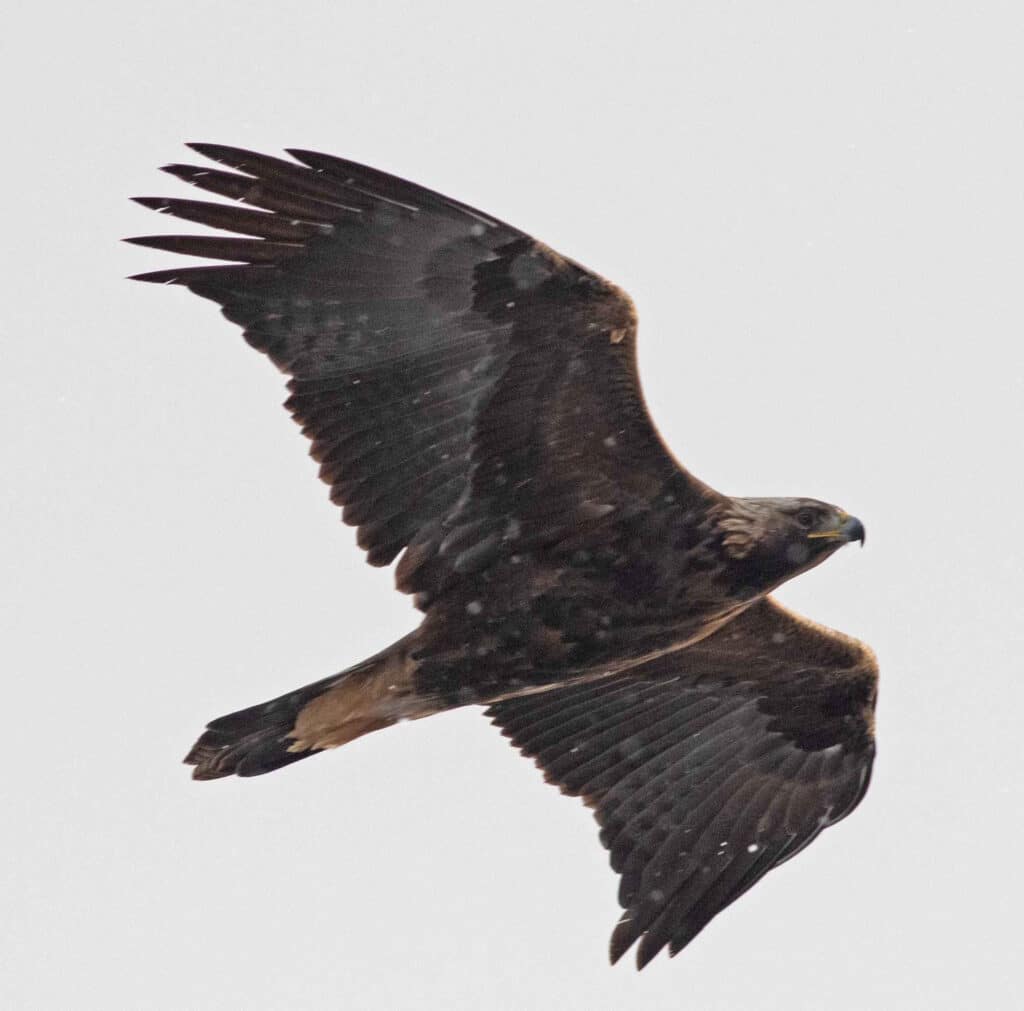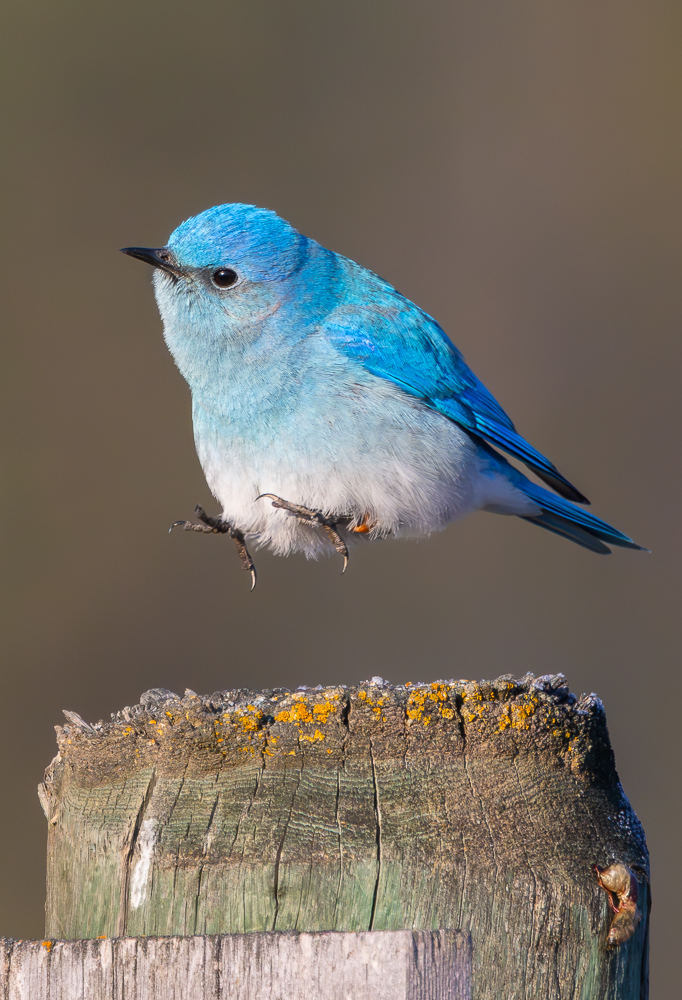
The Sacajawea Audubon Bluebird Trail Project was started by member Louis Moos in early 1969. While we don’t know the exact reason behind the idea of the bluebird trail, we can as sume that Audubon members had noticed a decrease in bluebird numbers around the Gallatin Valley by the 1960s. Because bluebirds are cavity nesters, they will readily adapt to using nest boxes. In this way humans can help offset the loss of natural cavities like tree snags.
The first mention of a bluebird trail was at the Oct. 7, 1968 Sacajawea Audubon Society monthly meeting at the Darigold Building in Bozeman, MT. One hundred bluebird boxes was discussed as a possible project.
At the Dec. 28, 1968 meeting, it was reported by George Gable that he had secured a truck load of scrap lumber for the construction of bird houses. It was decided that the February meeting would be held at the home of Cliff Davis and would be a work program assembling the bird houses. Mr. Gable would have the pieces all cut to proper size before the meeting.
At the Feb. 3, 1969 meeting, President Cliff Davis suggested Trail Creek Road as a fine place to put up the blue bird houses which the Society was to build. The meeting was adjourned to the Blue Bird Building Project. The houses were pre-cut by George Gable and the pieces fit perfectly. The holes were drilled and the covers fixed for easy removal for checking the nest and banding the baby birds. There were 20 carpenters in attendance.
Two quart milk containers were colored and painted by part of the group for use as experimental houses. Over 60 houses were constructed. Subsequently, the house construction was finished up on March 7th and the date of March 15th was set for installation.
The Bluebird Housing Project Report -1969 (excerpted from a report by Louis M. Moos)
The Sacajawea Audubon Society erected 50 birdhouses for Mountain Bluebirds during the spring of 1969. The wooden boxes were made to recommended bluebird specifications. The houses were constructed by Audubon members during the winter. The material for the houses was secured as scrap lumber from the sawmill at Belgrade. Forty boxes were erected on March 15th in the Trail Creek area southeast of Bozeman. The general area in which the bird- houses were placed is 1/2 mile south of the 16-mile sign on the Trail Creek Road, northward to 1/2 mile south of the old coke ovens. All but one of the boxes were on the north-east side of the road. There was a lot of snow on the ground and it was very difficult to reach the site where the houses were to be erected. Some of the snow was still 4 feet deep. A few people used snowshoes, but most of the members waddled through the snow to reach the sites for the houses. Several Boy Scouts assisted with the job. Nine boxes made of plastic milk cartons were erected in this same area. The group left town at 1 p.m. and were back at 5:30 p.m.
On April 23rd, ten boxes were placed at the US Fishery Research Center east of Bozeman. On May 4th one box was put up near the oiled road at the north end of Hyalite Canyon. Two plastic cartons were erected north of Belgrade along the gravel road and three in the fishing access near the Gallatin River bridge along the oiled road leading to Manhattan. Two prestone cans and two plastic cartons were erected south of Sunset Hills Cemetery east of Bozeman.
First observations of the nests were made on May 22nd by Mae Gable, and Mr. & Mrs. Cliff Davis. In general, use by bluebirds was very limited. Only two of the 50 boxes were used by bluebirds. Eight were used by house wrens, eight by tree swallows and one by a mountain chickadee. None of the plastic cartons were used. One prestone can placed near the cemetery was used by tree swallows. Only one box was used more than once – a bluebird in which the first nesting failed, and the second nesting was successful. Some of the houses will be moved this fall to new locations. Some need repair and the project will be continued another year.
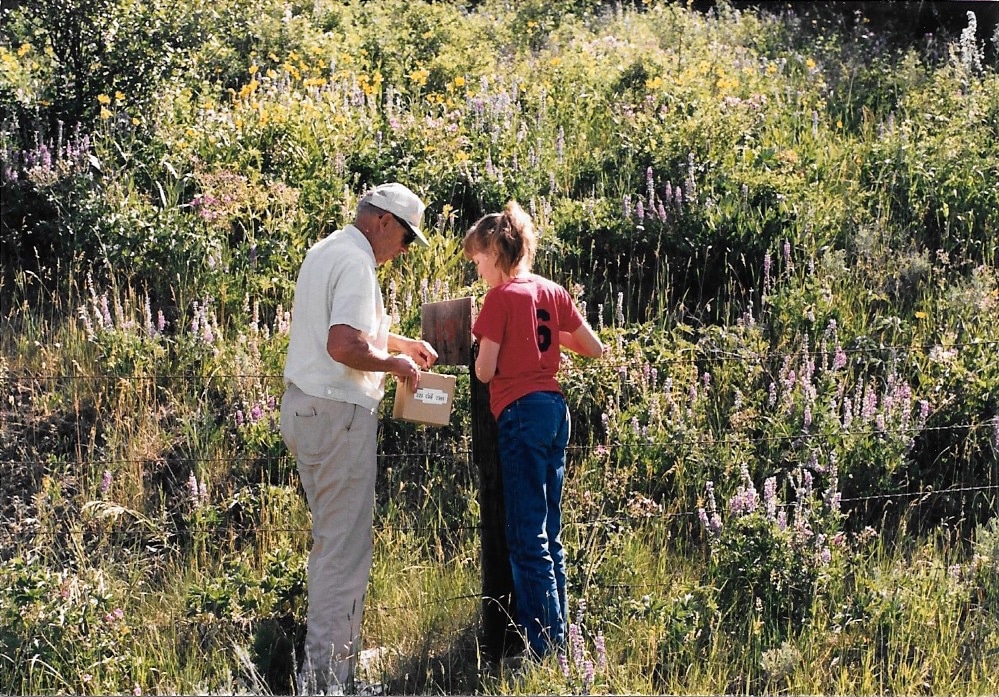
About Louis Moos
Louis was a biologist with the US Soil Conservation Service for many years. He was a bird enthusiast and bander who banded thousands of gulls in the Freezeout Lake area in the 1950s to the 1970s, raptors in the Gallatin Valley, and cavity nesting birds from the 1960s until his death in 1990.
Early 1970s
In the early 70s, a trail was started in the Pass Creek area NW of Bozeman. The Bird House Committee reported installing 10 bird houses in 1971, and that bluebirds had already been seen up there. Louis Moos said that 32 houses were added on Trail Creek. Eleven boxes were put up at the Fish Hatchery (now Bozeman Fish Technology Center), being placed where they could be seen by people driving through the hatchery. About that time Audubon members built several dozen nesting boxes from discarded grain chutes from a local mill. These boxes had smaller internal dimensions than recommended for bluebirds, but they seem to like them as well or better than the larger boxes, and many of them were still in use well into the 2010s. The old grain chute wood has proven to be nearly indestructible, though the added bottoms and lids have had to be replaced.
In 1973, Mary Geis placed 12 nest boxes at the top of Kelly Canyon near her home. By 1980, that had increased to 180 boxes along Kelly Canyon Road north to Bridger Canyon. Starting from 7 pairs of Tree Swallows and one pair of House Wrens in 1973, the number of nesting pairs increased to 62 swallows (producing 227 nestlings), 58 pairs of wrens (producing 370 nestlings), and 13 pairs of Mountain Chickadees (producing 44 nestlings) in 1979. The boxes were used less by bluebirds, and Mary reported 9 nesting pairs of Mountain Bluebirds (produc- ing 36 nestlings) in 1980. As Mary noted in later years, bluebirds in the Kelly Canyon/Bridger Canyon area didn’t do as well, due to marginal habitat, competition with swallows & wrens, more human activity, and perhaps more than enough nesting boxes.
Mary began banding under Louis Moos in 1977, and under her own permit by 1979. Later, she was assisted by Ginny Havens as a subpermittee. Ethel Fogelsong and Mary Ahlers began helping Louis in 1988 and continued to monitor and expand the trails after his death in 1990.
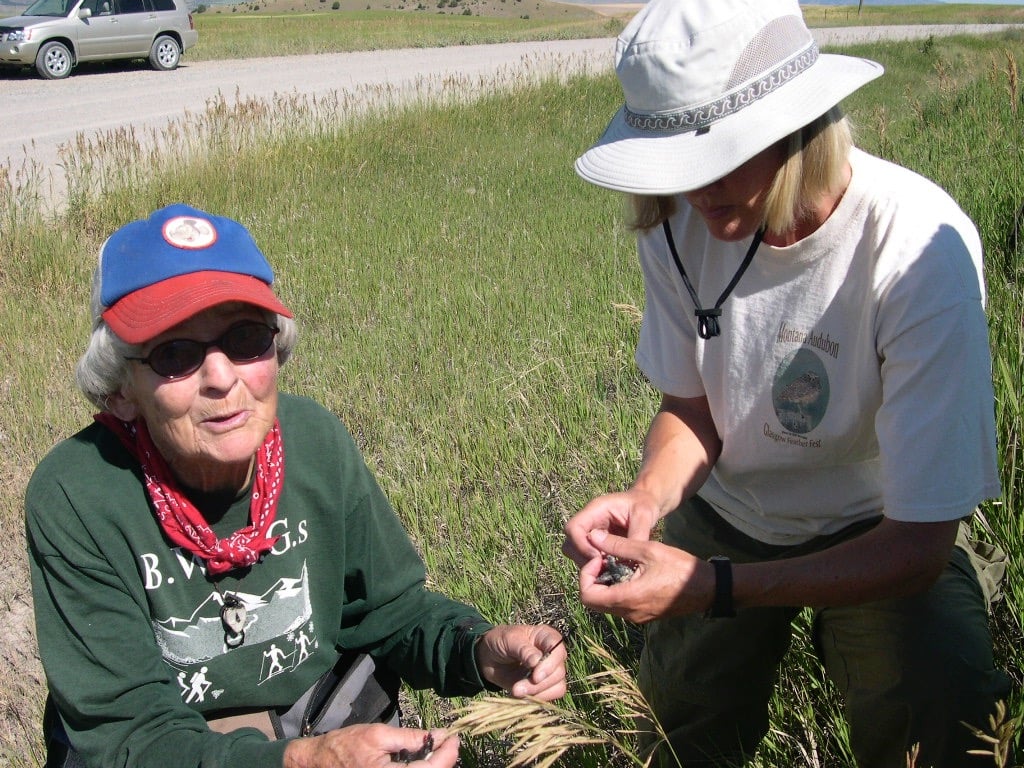
About Mary Geis
Mary was a trailblazing woman in the male-dominated field of biology. She attended the Yosemite School of Field Natural History in the late 1940s, and later received her graduate de- gree from the University of Montana. She settled in Bozeman with her husband Tony, teaching at a public school. It was here that she became involved with Sacajawea Audubon and met Louis Moos. She had a natural curiosity about bluebirds in the Gallatin Valley and started her own bluebird trail in Kelly Canyon (see above). She took over the Sacajawea Audubon bluebird trail project from Louis in 1979. Mary loved crunching numbers and created many charts and graphs tracking bluebird, swallow, wren and chickadee nesting statistics. Using her nesting data, she concluded that local Tree Swallows consumed 1,000 pounds of insects each summer. Each nest record she collected was carefully written down and sent in to the Cornell Lab of Ornithology. According to Cornell, Mary submitted nearly 1,500 Mountain Bluebird records during a 30 year span.
Audubon Society Bluebird Trails Report – 1988 (from a report by Louis Moos)
1988 was a successful year for the bluebird trail program. The number one problem was securing help with the increased number of checks made to each nesting box this season. Five trips were made to each box on both Pass Creek and Trail Creek. Checking boxes, keeping records for the nesting card program and banding young and adult birds was time consuming. It took about 8 hours, using three people to do the Pass Creek Trail during the peak of the nesting season. A large number of miles were clocked. About 900 miles were driven during the May through July trips. Credit for assistance this year goes to Fred and Pam Boettcher, Jim and Jeanne Waldo, Harry Cockrum, Jean Thorson, and Mrs. Fogelsong and her daughter. The Fogelsongs’ assisted with the Trail Creek project.
More bluebirds than ever were banded this year. The 40 bluebird boxes placed in the Willow Creek area by Jim and Jeanne Waldo were very successful. There is room for at least 50-75 additional boxes in both the Pass Creek and Trail Creek areas. The birds banded in 1988 do not represent all of the birds produced. We tried to visit each box in time to catch all of the young before they fledged. However, we missed some of the young that left between visits.
Numbers of birds banded in 1988:
| Mountain Bluebird | 588 |
| Tree Swallow | 149 |
| House Wren | 22 |
| Mountain Chickadee | 10 |
| TOTAL | 769 |
Nesting cards have been prepared for all nesting boxes and forwarded to the Laboratory of Ornithology, Cornell University, New York, New York. The Sacajawea Audubon Society had credit for over 4,000 nesting cards before this season’s report. Banding records are all filed with the U.S. Fish and Wildlife Service, Washington, DC. This agency also supplies all of the bands. We have no band returns to indicate where the bluebirds spend the winter.
Nests are often disturbed or destroyed with no apparent explanation. Occasionally, both tree swallow and bluebird eggs are found in the same nest. Apparently, tree swallows can take over a bluebird nest. We had one unusual record of a bluebird nest which contained one house sparrow egg along with the bluebird eggs. On the nest visit, there were two bluebird eggs and two house sparrow eggs. Both of the adult bluebirds were found dead in the nest.
Some observations from the 1988 nesting cards:
- Bluebirds do return to the same area where they were hatched. Some returned the first year and some the second.
- Some boxes produce two broods per year.
- One box had two broods produced by the same female (we don’t know if the male was the same).
- One female nested in the same box two years in a row.
- The normal number of eggs for bluebirds is 5 or 6.
- Mountain chickadees have 8 or 9 eggs, and house wrens may have up to 8 eggs.
- Most boxes are used by bluebirds. Tree swallows use some, and one box has had mountain chickadees every year.
- House wrens use boxes located close to trees and shrubs.
Sedan Trail – 1992
The Sedan Bluebird Trail was established by Ethel Fogelsong and Mary Ahlers in 1992. They used money donated to SAS in memory of Louis Moos to create the trail in his honor. Located along the eastern foot of the Bridger Mountains in the Flathead Creek area, a total of 61 nest boxes were installed to start. 16 additional boxes were added at the end of the first season. 187 bluebirds fledged with very little failure. 85 tree swallows and 1 brood of 4 mountain chickadees rounded out that first season. The Sedan Trail is still monitored, currently by Markie Nathan and Ginny Havens, after long-time monitor Tove Hunter passed away in 2020.
SAS Bluebird Trail – 2007 to Present
In 2007, Mary Geis was looking for volunteers to help with bluebird trail monitoring and placed an article in the Sacajawea Audubon newsletter. Lou Ann Harris was a new chapter member and thought it would be interesting to get involved with the bluebird project. Mary took Lou Ann out on the Rocky Mountain Rd. trail in May, and immediately began training her to band Mountain Bluebirds and Tree Swallows. After that first season helping Mary, Lou Ann took over as monitor of Rocky Mountain Rd. Mary continued to come along on nest box visits, but she was busy with her own trail on Kelly Canyon. By 2009, at the age of 84, Mary was ready to retire and turned the whole project over to Lou Ann. After Mary let her Master Banding Permit lapse, Lou Ann received hers in 2010 to continue banding bluebird nestlings and adult females caught on the nest. Only one adult male bluebird has ever been caught (2018). He was previously banded as a nestling in 2016 in the same area. To date, Lou Ann has banded over 2,000 bluebirds. During the past 10 years, over 120 of those banded bluebirds have been recaptured, some of them multiple times. The oldest Mountain Bluebird recaptured was at least 6 years old. There has never been a band return from our bluebirds’ wintering grounds. We can only guess as to their wintering location. With the introduction of songbird-sized satellite tracking devices, the idea of putting a few on our adult females was hatched. If successful, this could answer the question of where they go in the winter. More research on how to make this happen is needed.
As long as the bluebird trail has existed, it has hosted a number of cavity nesting species, primarily Mountain Bluebirds and Tree Swallows. But a number of other species have used the nest boxes, including: House Wren, Mountain Chickadee, and Violet-green Swallow. The occurrence of a nesting Western Bluebird was a trail first in 2014. A female Western Bluebird supposedly mated with a male Mountain Bluebird and laid a clutch of 5 eggs. She was caught and banded, and recaptured a second time, still incubating eggs. The eggs were found abandoned a couple of weeks later, evidently infertile. There has also been a continuing problem with House Sparrows using some boxes. In some cases, they have killed bluebird or swallow adults and taken over the box to build a nest and lay eggs. Whenever a House Sparrow nest is found, it is removed (along with eggs and/or nestlings). Predation of the boxes is a continuing problem. Raccoons, snakes, weasels and kestrels are the most common predators of bluebird nests. An attempt to reduce predation was mounted in 2021 with 20 Noel Guards installed on the worst hit boxes. At the end of the season, they were deemed mostly ineffective.
Mountain bluebirds use a variety of nesting materials, including dry grass, animal hair, and more recently, man-made items such as bits of plastic tarp and baling twine. In 2021, the first evidence of nestling mortality due to baling twine in the nest was observed. Two fully feathered nestlings were badly caught in the twine and unable to fledge. The remainder of the nestlings from that box fledged successfully.
In December 2019, Lou Ann was contacted by Becca Rodomsky-Bish at Cornell Lab of Ornithology. Becca was in charge of digitizing the 300,000+ written nest cards in their collection (NestQuestGo!). Amazingly, a large percentage of the nest cards for Mountain Bluebirds came from the SAS bluebird trails in Gallatin County. She wanted to know what happened to the data after the 1990s, when the nest card program ended. Lou Ann told her the bluebird trail was still active and that the chapter had nesting data from the early 2000s forward. This was exciting news for Becca since it would mean the SAS bluebird trails would be one of the richest datasets of a bluebird species for one location. What followed was a months-long process of entering 14 years of nesting data for each box on the Rocky Mountain Rd and Dry Creek/Pass Creek trails. This was accomplished by a few SAS volunteers via Cornell’s NestWatch website. It’s hoped that additional trail data will be added in the future from Trail Creek, since it was the chapter’s first bluebird trail, established in 1969.
As of 2025, there were 6 monitored bluebird trails: Dry Creek/Pass Creek (53 Boxes), Rocky Mountain Road (43 Boxes), Sedan (80 boxes), Eagle Rock Reserve (30 boxes), Trail Creek- Gallatin Co. (23 boxes) & Trail Creek-Park Co. (28 boxes). The Kelly Canyon bluebird trail had fallen into disrepair since Mary Geis’s retirement, but Brittany Visscher has adopted the trail; rehabbing the boxes and monitoring them once again.




